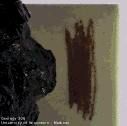GEM IDENTIFICATION


e.g., hexagonal prism vs. octahedra. This is based on internal atomic order and can not be determined from faceted crystals !
Note that some of these measurements are only possible if the gem stone is removed from its setting!
Specific gravity varies with chemical composition and crystal structure type.
These measurements are relatively straight
forward for stones in settings.
Because the
critical angle is determined by the refractive index,
measurement of the critical angle, specifically the angle at which
total internal
reflection occurs, allows determination of the refractive index.
RI=sin (CA) * N (N is a known number)) and "CA" is the critical angle:
Refractometers are the equipment used to measure the
critical
angle.
Specific minerals exhibit specific pleochroic colors.
Cabochons of Cordierite
exhibit this phenomena very clearly.
The behavior of light as it passes into a crystal depends upon the
structure and chemistry of the mineral.
An important test involves the use of two polarizing filters that are oriented nnormal to one another.
Note that in the absence of a crystal between the two sheets of polaroid,
light is
completely absorbed at the second sheet of polaroid.
The crystal is placed between the polaroid filters and the result is observed.
Other optical properties:
Determination of optical properties allows a gem to be assigned into a group, each group is consistent with either one or a small subset of the possible crystal systems. This can often be used to distinguish between possible identifications. If you don't understand how this works, please look at these examples
 "Diamonds and Diamond
Simulants"
"Diamonds and Diamond
Simulants"
OTHER TOOLS